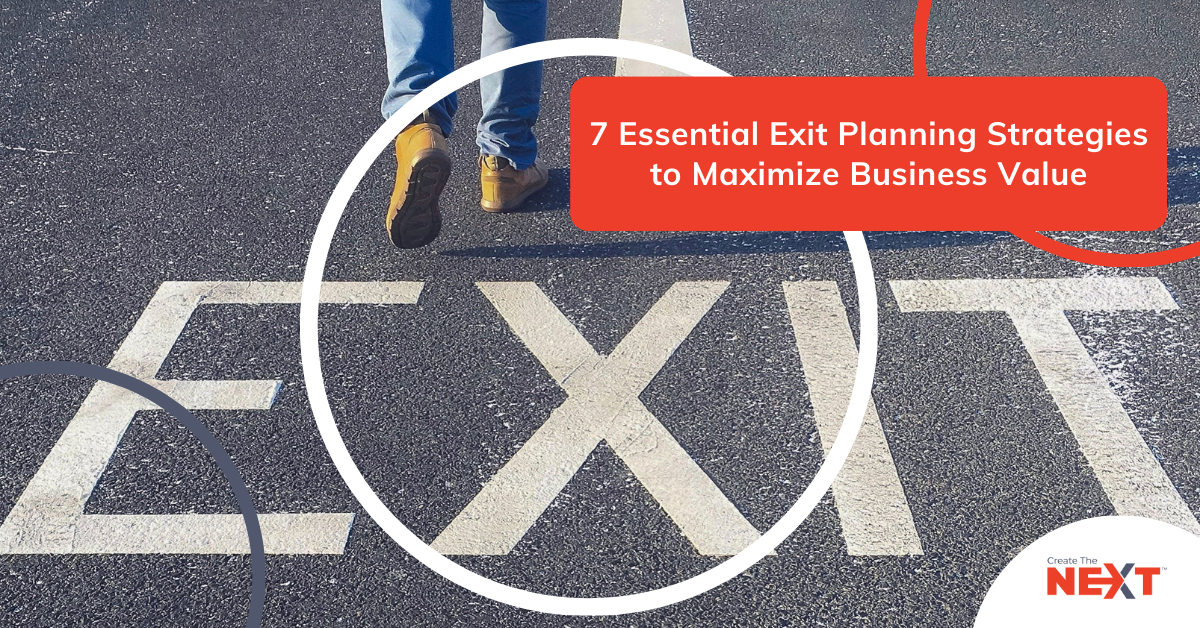7 Essential Exit Planning Strategies to Maximize Business Value
Feb 19, 2025
For small- and medium-sized enterprise (SME) owners, exiting a business is a major financial and personal decision that requires careful planning. Whether selling to a competitor, passing the business down to a successor, or transitioning to employee ownership, the process is complex. According to the Business Enterprise Institute, 80% of owners plan to exit within 10 years, yet only 30% have a plan. Without a proactive strategy, owners risk losing value or facing delays that could derail their exit.
Effective exit planning maximizes value, ensures a smooth transition, and secures financial stability for both the owner and future leadership. Successful SME exits require multi-year strategies addressing financial performance, operations, leadership, and due diligence. This article outlines seven key steps to help SME owners avoid pitfalls and achieve a profitable, seamless exit, positioning their business for long-term success.
1. Start Planning Early
The biggest mistake SME owners make when exit planning is waiting too long to start, resulting in lower sale prices, fewer buyer options, and increased risks. Planning three to five years in advance allows time for financial restructuring, operational improvements, and tax optimization, ensuring a smoother transition.
Early preparation strengthens financial performance, addresses inefficiencies, and reduces key-person dependencies, making the business more attractive to buyers. It also gives owners control over the process, preventing rushed decisions caused by market downturns, health issues, or unexpected challenges that could force an unfavorable sale.
2. Determine Your Exit Goals
An effective exit strategy starts with a clear definition of success, yet many SME owners fail to establish personal and financial objectives. While some focus on maximizing sale price, others prioritize employee job security, company legacy, or leadership transition. According to Business Process Management (BPM), over 75% of business owners regret their exit decision because it didn’t align with their long-term goals.
To avoid this, owners must consider key factors early. Will they sell to a third party, transition to family, or pursue an employee buyout? What financial outcome supports their retirement or next venture? Defining these priorities ensures an exit strategy that aligns with both business and personal goals, securing a successful transition. A fractional CFO plays a crucial role in this process by providing financial clarity, optimizing valuation, and ensuring liquidity, all of which support a seamless and strategic exit.
3. Get a Business Valuation
A common challenge for SME owners is misjudging their company’s value, leading to unrealistic pricing and difficulty attracting buyers. A professional valuation, often guided by a CFO, enhances credibility by providing a defendable price based on tangible data and projections, significantly impacting the sale price. Without one, owners risk undervaluing their business or overpricing it and struggling to sell.
Key valuation methods include earnings multiples for tech and service businesses, asset-based valuation for manufacturing and real estate, and market comparison against similar sales. A fractional CFO helps interpret these valuations, identify financial weaknesses, and implement strategic improvements before negotiations. Their expertise reinforces the asking price, boosting buyer confidence and reducing price cuts during due diligence.
4. Strengthen Financial Records and Management Team

Buyers seek transparent financial records and a strong management team to ensure business continuity post-sale. According to KPMG, businesses without a clear financial structure struggle to demonstrate stability, making it harder to attract buyers. Disorganized financial records create uncertainty about profitability and long-term viability, leading to hesitations or lower offers.
A resilient management team is key to a smooth transition. Buyers prefer businesses that operate independently, minimizing disruptions. SME owners, with the guidance of a fractional CFO, should train senior staff and gradually step back, ensuring financial stability and strategic oversight remain strong. This boosts buyer confidence, enhances market value, and ensures long-term success.
5. Improve Operational Efficiency
Operational efficiency boosts valuation, profitability, and buyer interest. According to McKinsey & Company, value-adding improvements enhance exit outcomes, as buyers prefer streamlined, low-waste businesses requiring minimal restructuring. Inefficiencies in workflows, overhead, or supply chains can raise red flags, leading to lower offers and prolonged negotiations.
To improve efficiency, SME owners should automate key processes to reduce costs and improve productivity. By identifying cost-saving opportunities, streamlining financial operations, and optimizing cash flow management, a fractional CFO helps ensure financial stability. Strengthening supply chain management and vendor contracts enhances cost control while reducing unnecessary overhead boosts profitability. A profitable, scalable, and well-managed business is far more attractive to buyers, maximizing exit value.
6. Explore Potential Buyers or Successors
Finding the right buyer is one of the most challenging and time-consuming aspects of exit planning. Many SME owners have unrealistic valuation expectations, which can deter buyers, while others wait too long to start the process, limiting their options. For example, a manufacturing firm with outdated equipment and inconsistent financial records may struggle to attract investors. To maximize sale success, owners should identify and engage with potential buyers well in advance, allowing time to refine positioning, strengthen financials, and negotiate from a position of strength.
Exit options vary in tax and valuation implications. Selling to a strategic buyer, such as a competitor looking to expand production capacity, often yields the highest valuation. Private equity firms favor high-growth manufacturing businesses with efficient operations and strong cash flow, while an Employee Stock Ownership Plan (ESOP) ensures continuity. Exploring these options early helps secure the best deal and streamline due diligence.

7. Plan for Due Diligence and Develop a Transition Strategy
A well-prepared due diligence process speeds up a sale and reduces complications. Missing documentation or discrepancies can delay negotiations or deter buyers. SME owners, with the support of a fractional CFO, should ensure accurate financials, clear legal obligations, and well-documented processes to build confidence and secure a strong sale price. Furthermore, a May 2024 Deloitte study found that 35.2% of M&A professionals expect increased due diligence demands.
Beyond due diligence, a structured transition plan is essential for business continuity post-sale. Employees, customers, and vendors should be informed to maintain trust. A fractional CFO can help structure the financial aspects of the transition, ensuring stability during leadership changes. A clear handover plan—including leadership training and client relationship management—minimizes disruptions and ensures a seamless transition for all stakeholders.
Conclusion: The Key to Successful SME Exit Planning
A well-structured exit strategy ensures SME owners maximize value, minimize risks, and achieve a seamless transition. By planning early, strengthening financials, optimizing operations, and preparing for due diligence, owners can attract the right buyers and secure the best deal. At ProCFO Partners, we specialize in helping SME owners navigate the exit process, enhancing valuation, and ensuring a smooth transition. Contact us today to start planning your successful business exit.


